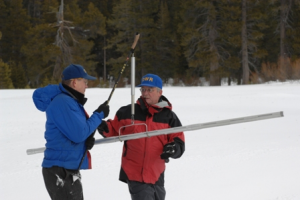
Snowpack surveys like the one pictured in this file photo are taking place to determine snow levels and the impact on the drought.
Precipitation and snow levels are higher this year thanks to El Niño conditions, but the drought is far from over, especially as the rains have targeted Northern California while Southern California has been comparatively dryer. That said, there have been benefits along the Colorado River Basin. Namely, a shortage declaration at Lake Mead, which supplies Colorado River to the Lower Basin states, including California, once anticipated for this year, has been pushed back to 2017. It is reasonable to think that additional storms and snow could go father in holding off any such shortage declaration.
But California and our neighboring Basin states are from out of the woods. It would take more than just one good season of rain and snow to move the West out of this cycle of drought.
That is why the difficult tasks of conservation must and will continue as established under the extension of regulations handed down by the State Water Resource Control Board. It has been said by one State Water Board official that the drought has brought with it lessons that are proving important for the future. That is a true statement. No matter when we move out of this cycle of drought, conservation will have to continue.
A farming group in the Imperial Valley – Imperial Valley Water (IVH2O) – held a water forum late in 2015 at the Palms Resort in Holtville in which it invited two environmental scientists to speak on drought conditions. They focused on climate change as a major factor in the current drought cycle, which adds a level of severity of drought different from cycles of drought from the past. Under these new conditions, they suggested the strongest tools we have to fight drought are conservation and storage.
The partners in the Quantification Settlement Agreement (QSA) have already shown leadership in these areas, providing an education to California and among all Colorado River Basin States what can be accomplished when water agencies work together. We have all taken innovative steps as partners and as individual agencies to serve our constituents, address the drought and support the State through this difficult time.
No matter what El Niño continues to bring—no matter what snowpack levels are determined to be come April when they are evaluated—no matter how long a water shortage declaration on the Colorado is pushed back—our efforts will need to continue to ensure we are prepared for future cycles of drought that will come.
